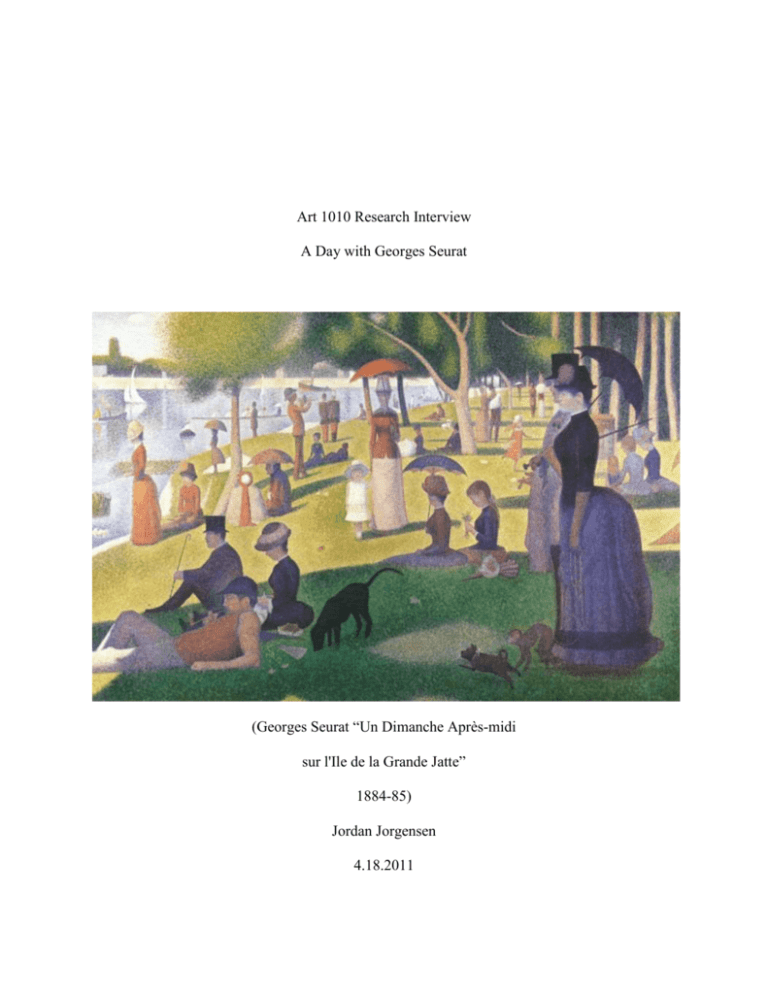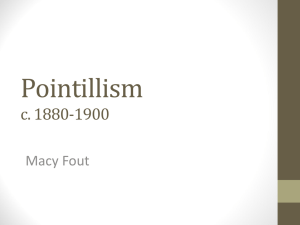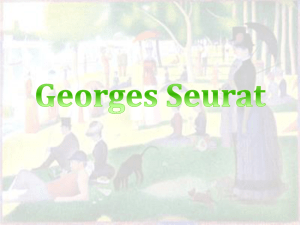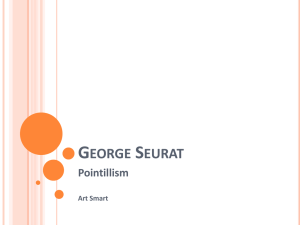Art 1010 Research Interview
advertisement

Art 1010 Research Interview A Day with Georges Seurat (Georges Seurat “Un Dimanche Après-midi sur l'Ile de la Grande Jatte” 1884-85) Jordan Jorgensen 4.18.2011 JORDAN J: Good morning Mr. Seurat. In this interview we are going to be asking you many questions about your life and how art influenced you. To begin let’s hear a little bit about your childhood. GEORGES S: Bonjour Mr. Jorgensen. Please pardon my accent. It’s a heavy French accent that can be hard to understand at times. Let me tell you a little about my upbringing. I was born on December 2nd 1859 to a wealthy family in Paris, France. My father was a legal officer back in the 1800’s and my mother was a native Parisian that can be described these days as a homemaker. I remember my father as a stoic man who was very quiet and withdrawn and never home much. I think I inherited much of his same personality traits because I too have been described in the same manor. As a young man I was described by many as a handsome but secretive man. I was also different then my classmates. Instead of going and spending my money on food and drink I preferred to spend it on books. That’s where I like to think my love for art stemmed from. JORDAN J: Where did you study at during school? What made you want to use the style pointillism instead of the regular brush strokes popular at that time? GEORGES S: I studied at L’ecole des Beux-Arts which was the official Paris art school in 1878 when I entered. I didn’t like the way the regular brush strokes looked on the canvas and decided to try a relatively new technique later called pointillism. It’s a technique that people say I developed where I would apply small closely packed dots of unmixed color onto a white canvas. It wasn’t an easy method to develop and it took many hours of meticulous study and technique until I had it perfected. (Georges Seurat “La Parade” 1887-89) This is a section of my painting “La Parade” blown up so you can see the detail that goes into pointillism. It’s not just one color it’s many colors that blend together the farther away you look at it. JORDAN J: So after school what did you do? Did you continue with this style of painting once you graduated? GEORGES SEURAT: During my studies I took a break for a year to do some military service. During that time I missed art school and when I was in the barracks I began to do simple sketches of figures and ships. After my service I returned to Paris and moved into a small flat with some fellow painting students and really devoted myself to mastering the skill I had learned in the military called black and white drawing. I soon found myself working on one of the paintings that would become a part of my life’s work. It was called “Baignade a Asnieres” or Bathing at Asnieres. (Georges Seurat “Bathing at Asnieres” 1883-84) As you can see I used what I had learned about sketching in the military and applied my pointillism techniques to the painting. This was my first major painting. My favorite things to paint began to be family outings just like the ones I used to take with my mother as a child. In 1884 I took this painting to the Salon Jury, which was the official art exhibition at L’ecole des Beaux arts where I attended school. They rejected my painting because it wasn’t the traditional style of painting during those days. I decided I was going to change my career path at that point and from then on I allied myself with a group of young independent painters. I scorned the salon jury and the school and never did graduate from the academy. JORDAN J: So after you left the academy what happened with your career? How did it influence your art? GEORGES S: After deciding to leave the academy and pronounce myself an independent artist. People began to notice my pointillism technique and saw me as a leader in the independent painting world. In May and June 1884 right after the Salon jury had declined my painting “Baithing at Asnieres” it hung at the first exhibit of independent artists in Paris. We didn’t have much money to put on a show and sometimes we would just hold annual shows in different places around Paris. We never had a Salon Jury and any artist who wanted his art shown at our exhibit would be welcomed. I soon met a man by the name of Paul Signac who was 4 years younger than me and a self taught painter. He was influenced by modern day artists and took a great interest in me and my work. He was so much different than me in many ways, not only in his artistic views, but he was also a very extravagant and outgoing person. JORDAN J: Did your career begin to take off at that point? GEORGES S: In the summer of 1884 I began working on another painting that was about to define my career as an artist. I went to a place regularly on the island La Grande Jatte of Seine. It bordered a lake and my favorite spot was to sit on the edge and watch all the people go about their activities of the day. I went to the spot every day morning and night and just began to sketch. I completed the painting in 1886 and unveiled it with the impressionist group I had been associated with. (Georges Seurat “La Grande Jatte” 1886) JORDAN J: What was the reaction you got from La Grande Jatte? GEORGES S: The painting proved to be the most popular of the exhibit. I was hailed by critics who said I was the future of the impressionists. A man named Felix Feneon who was a particularly young and new critic became especially interested in me and my piece. He basically became my spokesman. He wrote a series of articles on contemporary art in the newly launched Vogue magazine. He paid special attention to my meticulous, scientific method of painting and expounded on it. After all the attention I received from my painting I soon found that I had become one of the most controversial figures in the artistic world. I found myself in the artistic city Montmartre with my own studio and a new focus on my career. I was studying with other artists of my time that included Degas, Gauguin, Van Gogh, and Toulouse-Lautrec. I knew people were criticizing my work or praising my name, but for my sake I just kept to myself and kept to my work. JORDAN J: What did your fame mean for your finances? GEORGES S: Because I was brought up with money in a wealthy family I never quite knew how to price my paintings. I was uneasy dealing with clients and didn’t know how to handle the money I was getting with my new found fame. I had basically down to earth and simplistic tastes when it came to money because I was not used to the extra income that I was getting. People also used to take my humble manner with expenses and clients as being somewhat poetic. I hated when people would describe me like that. I was not poetic at all, I described myself as having a method and that was it. I also didn’t want people to think that because I was so intrusive and withdrawn and meager with the price of my paintings that they could take advantage of me and take my method of painting. I did not want to lose any credit for pointillism that I had developed so, I kept and guarded the details and secrets of my method to almost an obsession. JORDAN J: What were your favorite pastimes during the year? GEORGES S: After all the fame and attention from my drawings I began to assume a somewhat routine lifestyle. During the winter months I would like to lock myself in my studio working on big pictures to unveil in exhibits during the spring. Once all the exhibits and things were done in the spring I would spend the summer months in one of my favorite spots the coasts of Normandy. I would work on small paintings like this one ( Georges Seurat “Le port de Gravelines” 1890) JORDAN J: What about family of your own? Did you ever have a wife and kids? Did they influence your art at all? GEORGES S: Late in 1889 I was about 30 years old when I moved away from my studio I had been working at in Paris and moved to a quieter street to focus on my family. I didn’t tell any of my family where I had moved and I soon met a young model named Madeleine Knobloch. A year later in February 1890 she gave birth to my only child and only son. We stayed a family and I raised my son as my own, even though I never married his mother, all while working on my art. I started to draw some paintings that were more centered on things that my son would enjoy like “Le Cirque.” It wasn’t until 2 days before my death that I introduced my young little family to my mother. (Georges Seurat “Le Cirque” 1890) JORDAN J: You died pretty suddenly, how did that happen? GEORGES S: I died just a year after my son was born. Doctors these days seem to think that I somehow had contracted a sort of meningitis. I was only 31 years old. Just the week before I had debuted my painting “Le Cirque” and my hero Puvis de Chavannes walked past it without so much as a glance. Some people said that it made me so sad and I died of sadness. My good friend Signac concluded that “our poor friend killed himself by overwork.” Maybe I had worked myself to the bone creating a new style of painting and working and perfecting it for the ten years I was a renouned artist of my time. Although, I am glad that I was able to create beautiful works of art during my short time on the earth and that I am able to influence many artists and painters in the future. JORDAN J: What advice would you give to young struggling artists these days? GEORGES S: I would just have to say that perserverance and hard work pay off. Although I was an introvert and not very social I think that helped to make it so I can perfect my art. I didn’t let anything distract me from creating great art. I never thought that in my day I would be an icon for artist for times to come. I also think that having great artists of my time surrounding me helped motivate me to create something different from everyone else. You need to be yourself and find the style of art that fits you. Do as I did and make sure that nobody tells you what to do and who to be. If I had listened to my instructors and continued at the academy I would have been just like everyone else. Pointillism was hard work and took many many years to perfect and create. The biggest thing is just perservere and don’t let anyone get in your way and you will be able to do something great. JORDAN J: Thanks for your time Mr. Seraut, and thanks for the words of inspiration. GEORGES S: You’re very welcome, it was a great pleasure sharing my experiences and my life with you. Works Cited Georges Seurat (Getting to Know the World's Greatest Artists) by Mike Venezia March 2003. Georges Seurat: Figure in Space (Art to Hear) by Christoph Becker, Gottfried Boehm, Wilhelm Genazino and George Seurat April 2005 Masters of Art: Seurat by Pierre Courthion September 1988 http://www.renoirinc.com/biography/artists/seurat.htm http://www.ibiblio.org/wm/paint/auth/seurat/








